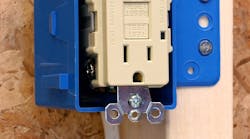What is ground-fault protection? The answer depends on whether you are talking about ground-fault protection of equipment or ground-fault protection of people. Just because ground-fault protection is present does not mean people are protected. To avoid confusion between personnel and equipment protection, always specify which one you mean.
If you picture a hierarchy of protection measures, ground-fault protection of equipment sits below the protection provided by breakers and fuses; it addresses ground faults of low magnitude only. It’s accomplished with a ground-fault relay, which is complicated to correctly set up and maintain. The NEC covers equipment ground-fault protection in Sec. 215.10, Sec. 230.95, Sec. 240.13, and Sec. 517.17. It is not our focus here.
Defining a GFCI
Regarding personnel safety, what people often mean by “ground-fault protection” is a ground-fault circuit interrupter (GFCI). Unlike equipment ground-fault protection, it doesn’t protect equipment. Unlike breakers or fuses, it doesn’t protect conductors. But it does protect people (up to a point).
Devices that provide GFCI protection include panel-mounted breakers, receptacles, and portable cords. GFCIs are also integral to some load utilization equipment.
Rather than being an end-all solution, the GFCI complements other safety measures, such as the use of double-insulated tools and the correct use/routing of portable cords. Don’t run portable cords through a puddle or in a way that exposes them to mechanical damage.
And, as NFPA 70E makes abundantly clear, every safety plan or program requires awareness and self-discipline on the part of the worker [Sec. 110.5(D)]. Don’t be lulled into complacency just because you (apparently) have GFCI protection.
How does it protect?
How does a GFCI work? When the current transformer in an undamaged GFCI senses enough difference in current potential between neutral and hot (4mA to 6mA), the GFCI will interrupt the circuit. Note that it’s sensing the potential between neutral and hot, not ground and hot. That’s why you can use it in a branch circuit that has no ground wire. When replacing an old receptacle on a 2-wire system, you should use a GFCI and affix the sticker that indicates no ground on that circuit.
What if the GFCI is damaged? A typical GFCI device provides power even if it no longer provides GFCI protection. Power transients, such as those induced by lightning, can damage a GFCI. A best practice for GFCI receptacles is to use the push button test periodically, depending upon how often you use that receptacle. Testing after a storm has passed is also a good practice. Before doing this with a branch-circuit breaker, remove (shut off) the loads so you don’t open the breaker under load.
For tools and other items with integrated GFCI protection, test the GFCI before and after each use. Testing it before seems like a no-brainer — that way you protect yourself from a shock while using it. But why test it after use? Doing so gives you time to replace the item before you need it again. Otherwise, when you need it again and the GFCI doesn’t work, are you sure you are going to stop work to get a replacement? Eliminate having to make that choice.
Where it's required
Because of all the checking and replacing that needs to be done with GFCI receptacles, portable cords, tools, and other gear, many construction companies use an assured equipment grounding (bonding) conductor program instead. If you have this program, OSHA doesn’t require GFCI protection.
Absent this program, you must have GFCI for:
- Outdoor work.
- Portable cords.
- Temporary wiring.
- Work that’s near any body of water, such as a fountain, spa, or pool.
Installing a GFCI receptacle
Every GFCI receptacle comes with instructions, but the gist is you:
- Identify the supply side. With power on and wires disconnected, use a voltage tester to identify the hot wire. The supply neutral is in that same cable jacket or raceway.
- Connect the supply side wiring to the LINE terminals.
- If you want to provide GFCI protection downstream of this receptacle, connect the wires from the other cable to the LOAD terminals.
Tips:
- If installing on a multi-wire circuit, ensure it’s not a single-pole unit (it won’t work on that circuit).
- Once you identify the LINE side wiring, mark it as such. If LINE and LOAD labels don’t come with the receptacle, use a label maker or even phasing tape.
- Before connecting the LOAD terminals, test the GFCI to ensure it works. If it does not, you have half as much troubleshooting to do. The most common mistake is the neutral and hot are swapped.
- Do not connect the ground wire to the neutral anywhere in the circuit (check the panel, also).
- Pigtails are an excellent idea for normal receptacles. With them, the device is not also serving the function of providing continuity of the neutral. You can remove the device and not affect the neutral downstream, but they prevent the sensing portion of the GFCI device from functioning.
If it trips:
- Visually check for what the cause might be, and correct as needed.
- Test again before using.
Grounding to prevent shock
Grounding on the supply side of the service or separately derived source helps protect the system from lightning and fault current. But it doesn’t protect anyone from being shocked by the touch potential between metal parts.
Since “ground” means a connection to the earth [see Art. 100], grounding on the load side is useless for preventing shock. You can prove this by drawing the circuit and applying Kirchoff’s Law of Parallel Circuits. Your body will draw enough current to kill you.
Bonding provides a very different outcome. Bonding puts metallic objects at the same potential so current cannot flow between them. Connecting to the earth doesn’t come anywhere close to doing this.
Why is that so? Bonding is done with metallic conductors, which (like circuit conductors) have extremely low resistance. There is, for all practical purposes, no current flow between bonded objects because the voltage difference between them is negligible. In practical terms, a bonding jumper has zero resistance. That is not the case for a patch of soil being used as a bonding jumper; in fact, the resistance of earth could be a billion times that of a copper conductor.
But doesn’t electricity follow the path of least resistance? So, wouldn’t that ground rod protect you by being the preferred path of electricity? No to both. Kirchoff’s Law shows us that current flows proportionately among the various paths before it based on an inverse relationship to the resistance of each path. If electricity took the path of least resistance, there would be no parallel circuits and thus no electronic devices or even an electrical infrastructure. The tricky part here is understanding how electricity divides if the path parallel to you is earth instead of a copper conductor.
Putting it all together
The purpose of ground-fault protection for personnel is to interrupt the circuit when the current transformer of the GFCI senses a (typically) 4mA to 6mA difference in current potential. Always test a GFCI before relying on it. Always practice awareness and self-discipline.
Grounding cannot possibly protect personnel from touch potential, and it does not create equipotential. Bonding, on the other hand, serves both purposes well. Utilization equipment and nearby metallic objects should be bonded to each other and the equipment grounding (bonding) conductor. Bonding, combined with proper installation and use of GFCI devices, dramatically reduces the likelihood of lethal shock.
Since the start of commercialized electricity, “ground” has often been used in place of “bond.” The resulting confusion reduces safety. To avoid confusion, memorize the Art. 100 definitions. For “ground,” that definition is just two words: “the earth.” We dig copper ore out of the earth and refine it to make bonding conductors; we don’t use the earth itself as a bonding conductor.
Lamendola is an electrical consultant based in Merriam, Kan. He can be reached at [email protected].




